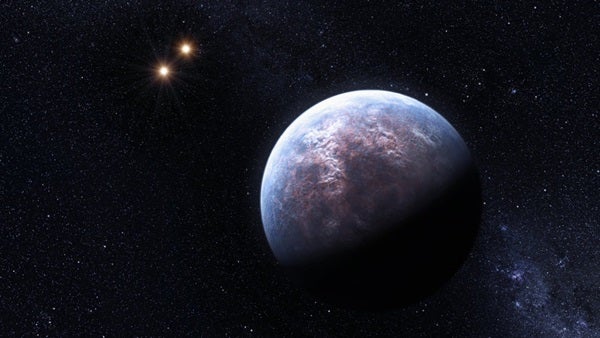Today, October 19, at an international European Southern Observatory (ESO)/Center for Astrophysics, University of Porto (CAUP) exoplanet conference in Porto, Portugal, the team who built the High Accuracy Radial Velocity Planet Searcher (HARPS), the spectrograph for ESO’s 3.6-meter telescope, reports on the discovery of some 32 new exoplanets, cementing HARPS’s position as the world’s foremost exoplanet hunter. This result also increases the number of known low-mass planets by an impressive 30 percent. During the past 5 years, HARPS has spotted more than 75 of the roughly 400 or so exoplanets now known.
“HARPS is a unique, high-precision instrument that is ideal for discovering alien worlds,” said Stephane Udry, who made the announcement. “We have now completed our initial five-year program, which has succeeded well beyond our expectations.” The latest batch of exoplanets announced today is comprised of 32 new discoveries. Including these new results, data from HARPS have led to the discovery of more than 75 exoplanets in 30 different planetary systems. In particular, thanks to its amazing precision, the search for small planets, those with a mass of a few times that of Earth — known as super-Earths and Neptune-like planets — has been given a dramatic boost. HARPS has facilitated the discovery of 24 of the 28 planets known with masses below 20 Earth masses. As with the previously detected super-Earths, most of the new low-mass candidates reside in multi-planet systems, with up to five planets per system.
In 1999, ESO launched a call for opportunities to build a high resolution, precise spectrograph for the ESO 3.6-meter telescope at La Silla, Chile. Michel Mayor, from the Geneva Observatory, led a consortium to build HARPS, which was installed in 2003. It soon measured the back-and-forward motions of stars by detecting small changes in a star’s radial velocity — as small as 2.2 miles (3.5 kilometers) per hour. Such precision is crucial for the discovery of exoplanets, and the radial velocity method that detects small changes in the radial velocity of a star as it wobbles slightly under the gentle gravitational pull from an (unseen) exoplanet, has been the most prolific method in the search for exoplanets.
In return for building the instrument, the HARPS consortium was granted 100 observing nights per year during a 5-year period to carry out a systematic search for exoplanets implemented worldwide by repeatedly measuring the radial velocities of hundreds of stars that may harbor planetary systems.
The program soon proved successful. Using HARPS, Mayor’s team discovered in 2004 the first super-Earth (around Mu Arae, ESO 22/04); in 2006, the trio of Neptunes around HD 69830 (ESO 18/06); in 2007, Gliese 581d, the first super Earth in the habitable zone of a small star (ESO 22/07); and in 2009, the lightest exoplanet so far detected around a normal star, Gliese 581e (ESO 15/09). More recently, they found a potentially lava-covered world, with density similar to that of Earth’s (ESO 33/09).
“These observations have given astronomers a great insight into the diversity of planetary systems and help us understand how they can form,” said team member Nuno Santos.
The HARPS consortium was very careful in their selection of targets, with several sub-programs aimed at looking for planets around solar-like stars, low-mass dwarf stars, or stars with a lower metal content than the Sun. The number of exoplanets known around low-mass stars — called M dwarfs — has also increased dramatically, including a handful of super Earths and a few giant planets challenging planetary formation theory.
“By targeting M dwarfs and harnessing the precision of HARPS, we have been able to search for exoplanets in the mass and temperature regime of super-Earths, some even close to or inside the habitable zone around the star,” said co-author Xavier Bonfils.
The team found three candidate exoplanets around stars that are metal-deficient. Such stars are thought to be less favorable for the formation of planets, which form in the metal-rich disc around the young star. However, planets up to several Jupiter masses have been found orbiting metal-deficient stars, setting an important constraint for planet formation models.
Although the first phase of the observing program is concluded, the team will pursue their effort with two ESO Large Programs looking for super-Earths around solar-type stars and M dwarfs, and some new announcements are already foreseen in the coming months, based on the last five years of measurements. There is no doubt that HARPS will continue to lead the field of ground-based exoplanet discoveries, especially pushing towards the detection of Earth-type planets.










